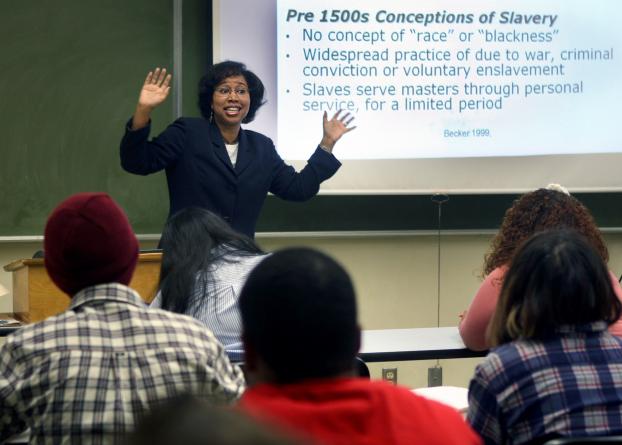 Caption: Lezlee Hinesmon-Mathews talks about slavery during her "History of Racism" class. Photo by Karen Tapia
Caption: Lezlee Hinesmon-Mathews talks about slavery during her "History of Racism" class. Photo by Karen Tapia
The History of Racism
Professor Teaches Course With Aim to End Discrimination
ETHNIC MINORITIES possess characteristics regarded as different by the dominant group and suffer discrimination and prejudice, Lezlee Hinesmon-Matthews explained during a recent lecture of her History of Racism course.
She also dispelled a myth about minorities. “They’re not the lowest number in a group,” she said. “A minority can be any size group singled out for unfair treatment.”
For example, blacks outnumbered whites in South Africa from the 1940s to the 1990s yet the whites were in power, practicing apartheid.
For Hinesmon-Mathews, the subject is one she knows well, as a scholar who researches racism and as a person with first-hand experience.
She was growing up in Los Angeles and attending junior high when she was ridiculed because of the color of her skin.
“A teacher denigrated me and other children who arrived late to his science class,” Hinesmon-Matthews said. “Our school bus, full of African-American students, was caught in heavy traffic. As we entered the classroom, the teacher suggested that we should not bother to come because we would not do well in his class anyway.”
That teacher was proven wrong when Hinesmon-Matthews aced his class.
“Through education about the history of racism, students can become more aware of the impact racism has had on our society institutionally and individually,” the assistant professor of Afro-ethnic studies said. “I believe that racism can end, but it is an uphill battle for our society, and for many societies around the world.”
As part of her class, Hinesmon-Matthews’ students will hear a speaker from the Orange County Human Relations Commission talk about the county’s hate crimes. According to the Southern Poverty Law Center, there are a number of active hate groups, including white nationalists, racist skinheads and neo-Nazis, in Orange County.
“Through the monitoring of hate crimes and through victim support, the impact of hate crimes can diminish,” she said, adding that legislation banning hate crimes also “goes a long way to combat racism.”
Hinesmon-Matthews’ students examine institutional racism such as housing and lending discrimination, compare their experiences growing up in racially integrated or segregated communities and dissect bigotry as expressed through name-calling and stereotyping.
“We also examine strategies to address racism,” she said. “The 1960s civil rights activism to resist voter intimidation and protect voter rights and the role of college students during ‘freedom rides’ in formerly segregated Southern states like Mississippi are two examples.”
Through her research, HInesmon-Matthews has studied why people are racist and how they can fight it.
“The degree to which people are racist is a product of their socialization,” she said. “Studies show that when people interact more and reduce social distance, racism and prejudice decreases.”
February 2, 2011
